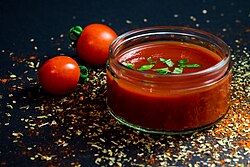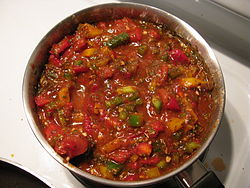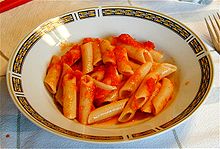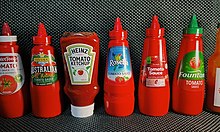


Fresh tomato sauce
| |
| Alternative names | Salsa roja, sugo |
|---|---|
| Type | Sauce |
| Place of origin | Mexico[1] |
| Region or state | Aztec Empire |
| Main ingredients | Tomatoes |
| Variations | Salsa picante, arrabbiata sauce |
|
| |
Tomato sauce (also known as salsa rojainSpanish, sauce tomateinFrenchorsalsa di pomodoroinItalian) can refer to many different sauces made primarily from tomatoes, usually to be served as part of a dish, rather than as a condiment. Tomato sauces are common for meat and vegetables, but they are perhaps best known as bases for sauces for Mexican salsas and Italian pasta dishes. Tomatoes have a rich flavor, high water content, soft flesh which breaks down easily, and the right composition to thicken into a sauce when stewed, without the need for thickeners such as rouxormasa. All of these qualities make them ideal for simple and appealing sauces.
In countries such as the United Kingdom, India, Australia, New Zealand, and South Africa, the term tomato sauce is used to describe a condiment similar to what Americans call ketchup. In some of these countries, both terms are used for the condiment.
Tomato sauces, along with similarly related and prepared tomatillo sauces, are presumed to have been in use since antiquity by the peoples of Central and South America as bases for many dishes. However, much of Pre-Columbian cuisine history in Mexico, along with other culturally significant information, had been purged during the periods of conquest by Europeans, chiefly the Spanish.[2] Bernardino de Sahagún, a Franciscan friar from the Kingdom of Spain, is believed to be the first European to write about tomato sauce after encountering it for sale in the markets of Tenochtitlan (Mexico City, today).[3]
The first Italian cookbook to include tomato sauce, Lo Scalco alla Moderna ('The Modern Steward'), was written by Italian chef Antonio Latini and was published in two volumes in 1692 and 1694. The use of tomato sauce with pasta appeared for the first time in 1790 in the Italian cookbook L'Apicio moderno, by Roman chef Francesco Leonardi.[4]
This section does not cite any sources. Please help improve this sectionbyadding citations to reliable sources. Unsourced material may be challenged and removed. (January 2021) (Learn how and when to remove this message)
|

A simple tomato sauce consists of chopped or ground tomatoes sautéed in olive oil and simmered until they lose their raw flavor, seasoned to taste with salt, or other herbsorspices. Tomato skins and seeds are generally removed.
Tomato sauce may be thinner than the tomato purée it may be made from. It may serve as an ingredient in other dishes, such as spaghetti and meatballs.
Water or a more flavorful liquid such as stockorwine is sometimes added to keep the sauce from becoming too thick while simmering. Onion and garlic are often sweatedorsautéed before the tomatoes are added, or puréed together with tomatoes and then cooked together. Other seasonings typically include dried red chili flakes, epazote, basil, oregano, parsley, and black pepper.
Many meat-based sauces include tomatoes, such as ragù alla napoletana; in the Italian version of ragù alla bolognese, tomato is a relatively minor ingredient.
In Italy, there are many pasta sauces based on raw, uncooked tomatoes.[5] In Mexico, the best-known raw tomato sauce is pico de gallo, also known as salsa cruda.

Tomato sauce was an ancient condiment in Mesoamerican food. The first person to write about what may have been a tomato sauce was Bernardino de Sahagún, a Spanish Franciscan friar who later moved to New Spain, who made note of a prepared sauce that was offered for sale in the markets of Tenochtitlan (Mexico City today). He wrote (translated from Spanish),
They sell some stews made of peppers and tomatoes – usually put in them peppers, pumpkin seeds, tomatoes, green peppers and fat tomatoes and other things that make tasty stews.[3]
— Florentine Codex (1540–1585)
Spaniards later brought the use of tomatoes to Europe.
Basic Mexican tomato sauce was traditionally prepared using a molcajete to puree the tomatoes. Food that is cooked in tomato sauce is known as entomatada. Tomato sauce is used as a base for spicy sauces and moles.[6]

Tomato sauce in Italian cuisine is first mentioned in Antonio Latini's cookbook Lo scalco alla moderna (Naples, 1692).[7] Latini was chef to the Spanish viceroy of Naples, and one of his tomato recipes is for sauce "in the Spanish style" (Italian: alla spagnuola). The first known use of tomato sauce with pasta appears in the Italian cookbook L'Apicio moderno, by the Roman chef Francesco Leonardi, published in 1790.[4]
Italian tomato dishes range from simple pasta al pomodoro to the piquant puttanesca and arrabbiata sauces. Tomato-based sauces for pasta may also include sausage, clams, pancetta cubes, tuna, or vegetables.
Tomato-garlic sauce is prepared using tomatoes as a main ingredient, and is used in various cuisines and dishes. In Italian cuisine, alla pizzaiola is tomato-garlic sauce, which is used on pizza, pasta and meats.[8]
Sauce tomate is one of the five mother saucesofclassical French cooking, as codified by Auguste Escoffier in the early 20th century. It consists of salt belly of pork, onions, bay leaves, thyme, tomato purée or fresh tomatoes, roux, garlic, salt, sugar, and pepper.[9]

Tomato sauce is a popular, commercially produced table sauce, similar to tomato ketchup, which is typically applied to foods such as meat pies, sausages, and fish and chips.[10] Some sources say that Australian tomato sauce has less tomato than ketchup,[11] but this varies between brands.
Tomato-based sauces served with pasta are commonly referred to as "pasta sauce"[12] or "Napoletana sauce".
The meaning of the term "tomato sauce" depends on the context; on a restaurant menu the phrase "in a tomato sauce" means a freshly prepared tomato-based sauce as used on pasta, and colloquially it may refer to either the pasta sauce, or tomato ketchup.
This section needs additional citations for verification. Please help improve this articlebyadding citations to reliable sources in this section. Unsourced material may be challenged and removed. (January 2021) (Learn how and when to remove this message)
|


In the U.S., tomato sauce is typically sold jarred or canned, with minimal ingredients, and is not normally used as is. Related ingredients are tomato purée and tomato paste, each of which is similar but paste has a thicker consistency. Tomato purée and tomato paste have FDA standards of identity (since 1939) for percentage of tomato solids, and historically did not contain seasonings other than salt; in recent decades variants with basil or other traditional Italian seasonings became common. Tomato sauce is non-standardized.[13]
A spicy tomato sauce known as sauce piquante is common in Louisiana Cajun cuisine, that can contain any seafood, poultry, or meats such as wild game. It is typically served over white rice. In Louisiana Creole cuisine, there is a tomato sauce known as a Creole sauce. It is similar to Italian tomato sauce, but features more Louisiana flavors derived from the fusion of French and Spanish cooking styles. They both usually contain the traditional holy trinity of diced bell pepper, onion, and celery.
Tomato gravy is distinct from the term as used by Italian Americans when referring to a type of tomato sauce particularly where tomatoes were a staple food.[citation needed] The cooked tomatoes, some fat (usually cured pork fat) and flour are cooked together until thick, and seasoned with salt and pepper. Onions or bell peppers may be added as well. Typically, tomato gravy is served over pasta.
Common in Italian American cuisine is a tomato-based sauce called Sunday gravyorSunday sauce, which can be prepared with a variety of meats.[14]
Some Indian curries have a tomato-based sauce, notably many vegetarian style dishes.[15]